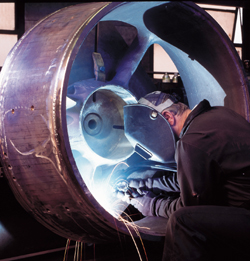Aluminum Bronze for When the Going Gets Tough
The versatility of the aluminum bronze alloys is well represented in the construction of new, state-of-the-art power plants. To generate power from fuels, it's essential that the exhaust steam from the turbines that drive the generators be condensed back into pure water, which is then recycled to the boilers. In power plants on or near the seacoast or where the cooling water is brackish, the big water pumps and condenser tube sheets can be made of corrosion-resistant aluminum bronze. These pumps draw in the cooling water that condenses the weak steam.
The vertical tube sheets for the condensers, which can weigh hundreds of tons, are aluminum bronze, although the horizontally-mounted tubes through which the condensing steam passes may be made of other metals, such as titanium, stainless steel, or copper-nickel.
Mussel Muscle
 Welding a large aluminum-bronze part with welding rods made of the same material.
Welding a large aluminum-bronze part with welding rods made of the same material.Aluminum bronzes are also used to repel zebra mussels, those fast-proliferating crustaceans that clog the water intakes to power plants and municipal water systems. It's the biostatic copper, up to 91% in one of these bronzes, that the mussels can't abide. Since the fast-reproducing crustaceans first invaded the western hemisphere in the bilge water of freighters, they have managed to spread throughout the Great Lakes and at least as far south as Florida.
In the past, those responsible for these systems have generally not taken advantage of biostatic copper grids or mesh to counter the threat of zebra mussels; instead, they've relied on divers to scrape the steel intakes clean. However, the Florida Power & Light Company did specify mesh made of aluminum bronze for the intakes of its big plant on the Indian River near Cape Canaveral. Concast Metal Products Co., Birmingham, Ohio, supplies the bronze in wire form to Barber Welding & Manufacturing, Bell Gardens, California, where it is woven into mesh. Barber in turn supplies the mesh to the makers of big pumps, such as Gould and Floway.
Variety of Applications
In addition to their critical role in power plants, the aluminum bronzes are specified for a great range of applications:
- The U.S. Navy picked aluminum bronze for such can't-fail applications as torpedo ejection systems for subs.
- In cleaning and treating metal parts, the pickling rods and baskets that suspend the parts in the chemicals are made of aluminum bronze.
- The huge presses that stamp out vehicle parts make good use of aluminum bronze, according to Olaf Schneider, an engineer with Ampco Metal, Inc, in Milwaukee.
- Aluminum bronze welding rods are widely used not only in fabrication of new parts for many applications, but for repair of bronze and steel parts as well.
- The U.S. Army Corps of Engineers specified aluminum bronze for the heavy chains that lift the massive flood gates on dams on the Mississippi River. According to Schneider, this is an application where long life is critical.
- Other products that need to survive in water are boat and ship propellers. According to Dominick Lemaire, Concast supplies C95800 aluminum bronze for the hubs and blades of props.
- Pumps that must resist acids are made of C95200.
- The U.S. Coast Guard has investigated another possible application for aluminum bronze: for the chains that anchor navigational buoys in place; the copper in the chains would repel zebra mussels, which would otherwise weigh the chains down so much the buoys would sink!
In addition to all the above, Concast's C95500 and C95520 bronzes serve a variety of other applications, such as valve seats and guides in internal combustion aircraft engines, wear strips, bearings, bushings, and worm gears. Tubing made of tough aluminum bronze is used in the landing gear for airliners. This tubing is continuously cast by several producers, including Materion Corporation (formally Brush Wellman), Cleveland, Ampco Metal, and Concast Metal.
Made in Many Forms
Producers supply these strong, tough, hard and, especially, corrosion-resistant bronzes in many forms: castings, forgings, sheet, plate, rod, pipe, custom shapes and extrusions, some heat-treated. The aluminum content of this broad range of bronzes varies from 6% (C61300 and C61400) up to 11.5% (C95500). They also contain iron up to 5.5% (C95500), tiny amounts of selenium (C61300 and C61400), and manganese up to 3.5% (C95500). Some of these bronzes contain enough nickel, from 2.5% (C95400) to 5% (C95800) to be known as nickel-aluminum bronzes.
Ampco Metal: 414/645-3750
Barber Welding: 562/928-2570
Materion Corporation (formally Brush Wellman): 216/486-4200
Concast: 440/965-4455
Also in this Issue:
- Aluminum Bronze for When the Going Gets Tough
- Euros Mostly Copper
- Father of the Mint
- New Coins Mostly Copper
- "Out of Sight" Wiring to Order
- Billions of Quarters
- Copper Roofs for Residences
- Sacagawea Depicted
